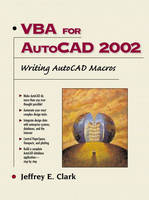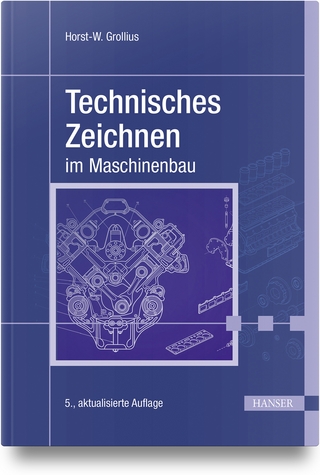
VBA for AutoCAD 2002
Prentice Hall (Verlag)
978-0-13-065201-0 (ISBN)
- Titel ist leider vergriffen;
keine Neuauflage - Artikel merken
AutoCAD 2002 isn't just the world's #1 design and drafting tool: it's a powerful, programmable platform for automating complex design tasks, integrating design data with enterprise information systems, and solving a wide range of technical and business problems. The key to all that power is VBA scripting -- and the key to VBA scripting is AutoCAD 2002 VBA User Handbook. This book ties together AutoCAD's key tools and VBA's capabilities as never before, showing how AutoCAD and VBA work together in the real world -- and helping professionals create real-world applications more rapidly than they ever thought possible. Jeffrey E. Clark begins with a tour of AutoCAD's Interactive Development Environment, then helps AutoCAD professionals master the fundamentals of Automation, COM, and object-oriented programming. Go "under the hood" with the DXF format to understand the structure of AutoCAD's drawing database; master the AutoCAD object model, and discover how to automate 2D and 3D graphic objects, external references, entities, modeled solids, dimensions, and events. Learn how to use VBA to control PaperSpace, Viewports, and plotting; and how to extend AutoCAD to communicate with other applications and across the Internet. The book also includes a start-to-finish case study application that integrates an AutoCAD drawing with a Microsoft Access database.
JEFFREY E. CLARK is project manager with a national consulting and systems integration firm specializing in facility management. He writes Visual Basic/VBA code on a daily basis to help create and maintain facility databases. An AutoCAD user for over 15 years, Clark has developed several commercial AutoCAD applications. His work has been featured in publications ranging from Cadalyst to Facilities Design & Management to PC Magazine.
(NOTE: Each chapter concludes with Summing Up.)
Preface.
Acknowledgements.
I. THE AUTOCAD VBA ENVIRONMENT.
1. Taking Control of AutoCAD.
Components and Automation. The Foundation. A High-Level View. Details. Creating a Drawing with Visual Basic. Setting Available References. Writing the Procedure. More About Components. AutoCAD Inheritance. Method, Property, and Event Matrices.
2. The VBA Environment.
Creating and Editing Your Macros. Design Windows. Debugging Windows. Managing and Running Your Macros. VBA Manager. Open VBA Project. Macros Dialog. AutoCAD Command Line.
3. DXF: Key to the Drawing Structure.
DXF Format. Objects and Classes. Fixed Group Codes. Variable Group Codes. Subclass Markers. Looking at Your Drawing with VBA. GetSubclass Reads a DWG File. DXFsearch Reads a DXF File. AutoLISP and VBA. Advantages of VBA. VBA Utility.
4. Elements of the Object Model.
Automation Interfaces. Application Object. Documents Collection. ModelSpace and PaperSpace. Table Collections. Object Collections. Document Object and Entities. Preferences Object. Custom Menus and Toolbars. MenuBar Collection. MenuGroups Collection.
II. USING THE AUTOCAD OBJECT MODEL.
5. Documents and the User Interface.
Methods and Properties. File Management. Creating a Drawing File. Opening, Saving, and Closing a Drawing. Wblock. Exporting and Importing Files. Other File Management Tools. User Interface. Windows. Zooming. Named Views. Viewports. Hyperlinks. AutoCAD Enums. Method, Property, and Event Matrices.
6. Collections and Objects.
Application Object. Methods. Properties. Document Object. Methods. Properties. Collections. Managing Collections. Methods. Properties. Table Collections. Layers. LayerStateManager. Linetypes. Registered Applications. TextStyles. User Coordinate Systems. Method, Property, and Event Matrices.
7. Utility Objects.
SelectionSets, Filters, and Groups. SelectionSets. Filters. Groups. Utility Object. Data Acquisition. Data Conversion. Internet Access. Dictionaries and the Xrecord. Method, Property, and Event Matrices. @CHAPTER 8. Blocks and External References.
Blocks. Accessing Block Objects. Accessing Block References. Attributes and Attribute References. Properties. Block with Data. MinsertBlock. Properties. Database. CopyObjects Method. Database Properties. External References. Methods. Redefining Xrefs. Layouts. Method, Property, and Event Matrices.
9. Entities.
Common Methods and Properties. Definitions. 3Dface. Methods. Property. 3Dpoly. Method. Properties. Arc. Properties. Circle. Properties. Ellipse. Properties. Hatch. Methods. Properties. LightWeightPolyline. Methods. Properties. Line. Properties. Mline. Properties. Mtext. Properties. Point. PolyfaceMesh. Properties. PolygonMesh (3DMesh). Method. Properties. Polyline. Methods. Properties. Raster. Method. Properties. Ray. Properties. Region. Method. Properties. Shape. Method. Properties. Solid. Spline. Methods. Properties. Text. Properties. Trace. XLine. Properties. Entity Methods, Properties, and Events.
10. Solids.
Box. Cone. Cylinder. EllipticalCone. EllipticalCylinder. ExtrudedSolid. ExtrudedSolidAlongPath. RevolvedSolid. Sphere. Torus. Wedge. Solid Editing Methods. Mass Properties.
11. Dimensions.
Concepts. Dimension Style Manager. Dimension Variables, Styles, and Overrides. Associativity. Dimension Types. Dim3PointAngular. DimAligned. DimAngular. DimDiametric. DimOrdinate. DimRadial. DimRotated. Leader. Tolerance. Dimensioning Properties. Lines and Arrows. Text. Fit. Primary Units. Alternate Units. Tolerances. Other Dimensioning Properties. Orphan DimVars. Dimension Methods, Properties, and Events.
12. Editing.
Editing Methods. Array. Copy. Explode. GetBoundingBox. IntersectWith. Mirror. Move. Offset. Rotate. ScaleEntity. TransformBy. Undo. Information Properties. Accessing the Command Line. Related Methods, Properties, and Procedures.
13. AutoCAD Events.
Application Events. Application-Level Events. Document Events. AcadDocument Event Handlers. Document-Level Events. Object Events. Event Handler Caveats.
14. Forms and Controls.
Command Events. Form Events. Tab Order. The Relative Utility. Relative Module. frmRelative Form. Control Methods and Properties.
15. PaperSpace and Plotting.
Plotting Interface. Plot Style Tables. Plotter Configurations. PaperSpace Layouts. System Settings. PlotConfiguration and Layout Objects. PlotConfigurations. Layouts. Common Methods and Properties. PaperSpace Viewports. Methods. Properties. Plot Object. Methods. Properties. BatchPlot. FrmPlotFiles. BatchPlot. Plotting Methods and Properties.
16. Preferences.
Programming Style. Files. Methods. Properties. Display. Display Performance. Display Resolution. Layout Elements. Window Elements. Open and Save. External References. File Safety Precautions. File Open and Save. ObjectARX Applications. Plotting (Output). Default Plot Settings for New Drawings. Default Style Behavior for New Drawings. General Plot Options. System. Database Connect Options. General Options. User Preferences. AutoCAD DesignCenter. Hyperlink. Lineweight Settings. Object Sorting Properties. Priority for Coordinate Data Entry. Windows Standard Behavior. Drafting. AutoSnap. AutoTrack. Selection. Grips. Selection Modes and Pickbox. Profiles. Methods. Preferences Methods, Properties, and Events.
17. Menus.
Custom Menus and Toolbars. Looking at the Menu Structure. Methods. Properties. Popup Menus. Toolbars. Saving Your Customizations. Method and Property Matrices.
III. COMMUNICATING WITH OTHER APPLICATIONS AND THE INTERNET.
18. Extensibility.
Extended Entity Data. Methods. Working with Polylines and XData. VBA Interface. Methods. Properties. Running VBA Remotely. Zero Document State. ARX Applications. Methods.
19. The Facility Project.
Microsoft Access Database. Tables, Keys, and Integrity Constraints. Designing the User Dialog. Developing the Queries behind the Dialog. AutoCAD/Access Interface. cboGroup_Change. 1stDepartment_AfterUpdate. 1stProgDetail_Click. Space Allocation.
20. The DWF Object Model.
Drawing Web Format. File Structure. Opcodes. Logical Coordinates. Excel Reader Application. XLocate. XLdwf. Whip! Object Reference. General Methods and Properties. Other Collections and Objects. Intrinsic Whip! Events. Whip! Methods and Properties.
Appendices.
Appendix A: System Variables.
Appendix B: Enums.
Appendix C: Object Inheritance.
Appendix D: DXF Formatting Utility.
Index.
| Erscheint lt. Verlag | 19.12.2001 |
|---|---|
| Verlagsort | Upper Saddle River |
| Sprache | englisch |
| Maße | 100 x 100 mm |
| Gewicht | 100 g |
| Themenwelt | Schulbuch / Wörterbuch ► Lexikon / Chroniken |
| Informatik ► Weitere Themen ► CAD-Programme | |
| ISBN-10 | 0-13-065201-6 / 0130652016 |
| ISBN-13 | 978-0-13-065201-0 / 9780130652010 |
| Zustand | Neuware |
| Haben Sie eine Frage zum Produkt? |
aus dem Bereich


